Java日期工具类LocalDateTime
发布时间:2023年12月29日
嘚吧嘚
压轴的来了,个人感觉LocalDateTime是使用频率最高的工具类,所以本篇像文章详细研究说明一下🧐。
如果看了Java日期工具类LocalDate和Java时间工具类LocalTime👍,那么本篇文章就算是一个整合、进阶吧😎。
LocalDateTime - API
创建时间
| 函数声明 | 描述 |
|---|---|
| static LocalDateTime now() | 获取默认时区的当前日期时间 |
| static LocalDateTime now(ZoneId zone) | 获取指定时区的当前日期时间 |
| static LocalDateTime now(Clock clock) | 从指定时钟获取当前日期时间 |
| static LocalDateTime of(LocalDate date, LocalTime time) | 根据日期和时间对象获取LocalDateTime对象 |
| static LocalDateTime of(int year, Month month, int dayOfMonth, int hour, int minute, int second) | 根据指定的年、月、日、时、分、秒获取LocalDateTime实例 |
LocalDateTime now()
获取指定时区、时钟的日期时间就不多做说明了,和LocalDate一样。
// 获取当前时间
LocalDateTime now = LocalDateTime.now();
System.out.println("now : " + now);
// 格式化
DateTimeFormatter formatter = DateTimeFormatter.ofPattern("yyyy-MM-dd HH:mm:ss");
String nowStr = now.format(formatter);
System.out.println("nowStr : " + nowStr);
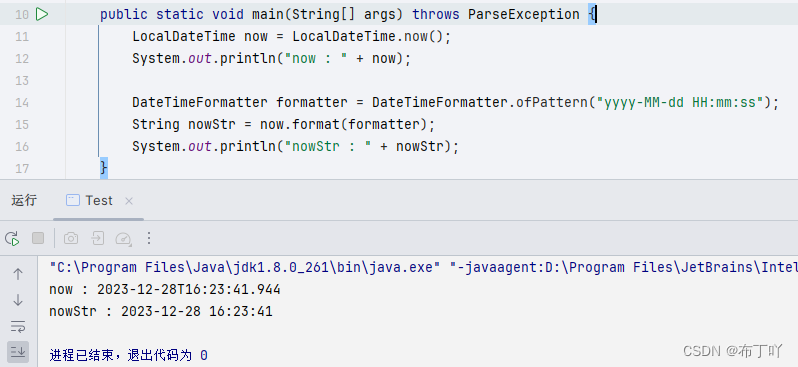
LocalDateTime of()
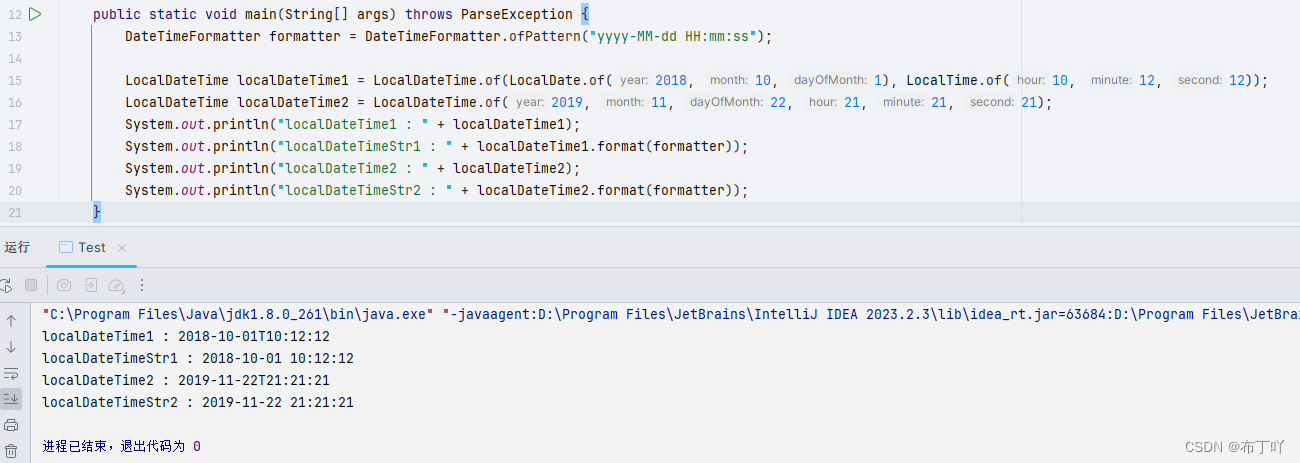
获取年月日时分秒
| 函数声明 | 描述 |
|---|---|
| int getYear() | 获取年份 |
| Month getMonth() | 获取月份,返回值为月份的枚举 |
| int getMonthValue() | 获取月份,返回值为int类型月份 |
| DayOfWeek getDayOfWeek() | 获取日期是星期几 |
| int getDayOfMonth() | 获取日期在该月是第几天 |
| int getDayOfYear() | 获取日期在该年是第几天 |
| int getHour() | 获取小时 |
| int getMinute() | 获取分钟 |
| int getSecond() | 获取秒钟 |
| int getNano() | 获取纳秒 |
LocalDateTime now = LocalDateTime.now();
// 获取年
System.out.println("getYear : " + now.getYear());
// 获取月份
System.out.println("getMonth : " + now.getMonth());
System.out.println("getMonthValue : " + now.getMonthValue());
// 获取日
System.out.println("getDayOfWeek : " + now.getDayOfWeek());
System.out.println("getDayOfMonth : " + now.getDayOfMonth());
System.out.println("getDayOfYear : " + now.getDayOfYear());
// 获取小时
System.out.println("getHour : " + now.getHour());
// 获取分钟
System.out.println("getMinute : " + now.getMinute());
// 获取秒
System.out.println("getSecond : " + now.getSecond());
// 获取纳秒
System.out.println("getNano : " + now.getNano());
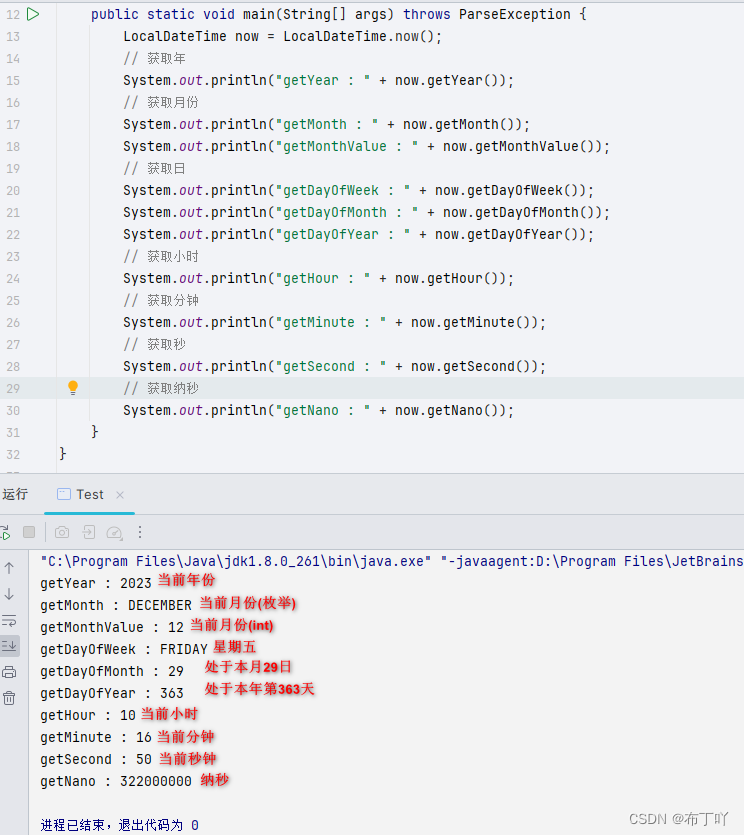
增加时间
虽然是增加时间,传参可为正数,也可为负数。传参为正数时增加,传参为负数时减少。
| 函数声明 | 描述 |
|---|---|
| LocalDateTime plusYears(long years) | 增加年 |
| LocalDateTime plusMonths(long months) | 增加月份 |
| LocalDateTime plusWeeks(long weeks) | 增加周 |
| LocalDateTime plusDays(long days) | 增加日 |
| LocalDateTime plusHours(long hours) | 增加小时 |
| LocalDateTime plusMinutes(long minutes) | 增加分钟 |
| LocalDateTime plusSeconds(long seconds) | 增加秒 |
| LocalDateTime plusNanos(long nanos) | 增加纳秒 |
增加年、月、周、日
LocalDateTime now = LocalDateTime.now();
System.out.println("now:" + now);
// 修改年份
System.out.println("plusYears : " + now.plusYears(1));
System.out.println("plusYears : " + now.plusYears(-1));
// 修改月份
System.out.println("plusMonths : " + now.plusMonths(1));
System.out.println("plusMonths : " + now.plusMonths(-2));
// 修改周
System.out.println("getDayOfWeek : " + now.plusWeeks(1));
System.out.println("getDayOfWeek : " + now.plusWeeks(-2));
// 修改日
System.out.println("plusDays : " + now.plusDays(3));
System.out.println("plusDays : " + now.plusDays(-3));
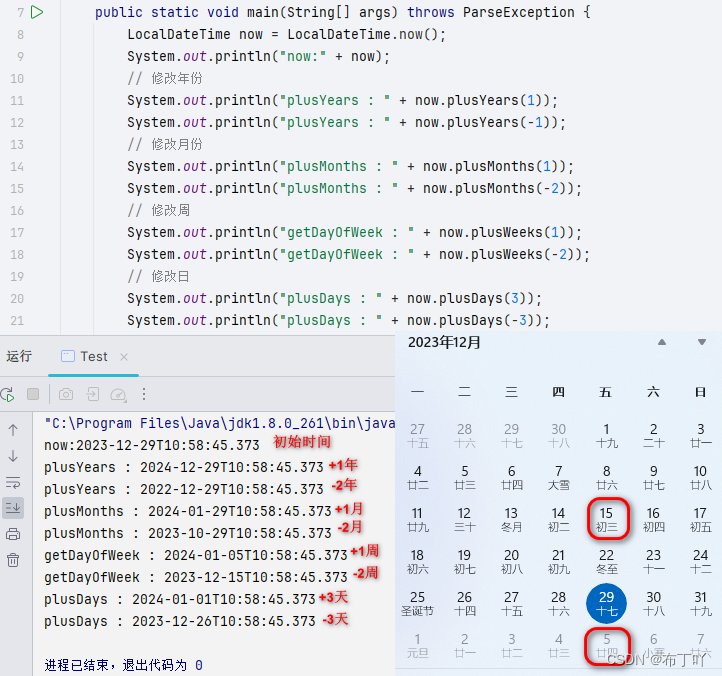
增加时、分、秒、纳秒
LocalDateTime now = LocalDateTime.now();
System.out.println("now:" + now);
// 修改小时
System.out.println("plusHours : " + now.plusHours(2));
System.out.println("plusHours : " + now.plusHours(-5));
// 修改分钟
System.out.println("plusMinutes : " + now.plusMinutes(20));
System.out.println("plusMinutes : " + now.plusMinutes(-15));
// 修改秒
System.out.println("plusSeconds : " + now.plusSeconds(11));
System.out.println("plusSeconds : " + now.plusSeconds(-31));
// 修改纳秒
System.out.println("plusNanos : " + now.plusNanos(53));
System.out.println("plusNanos : " + now.plusNanos(-63));

减少时间
虽然是减少时间,传参可为正数,也可为负数。传参为正数时减少,传参为负数时增加。
| 函数声明 | 描述 |
|---|---|
| LocalDateTime minusYears(long years) | 减少年 |
| LocalDateTime minusMonths(long months) | 减少月份 |
| LocalDateTime minusWeeks(long weeks) | 减少周 |
| LocalDateTime minusDays(long days) | 减少日 |
| LocalDateTime minusHours(long hours) | 减少小时 |
| LocalDateTime minusMinutes(long minutes) | 减少分钟 |
| LocalDateTime minusSeconds(long seconds) | 减少秒 |
| LocalDateTime minusNanos(long nanos) | 减少纳秒 |
减少其实也是调用的增加的方法

以减少年为例
LocalDateTime now = LocalDateTime.now();
System.out.println("now:" + now);
// 减少年
System.out.println("minusYears : " + now.minusYears(2));
System.out.println("minusYears : " + now.minusYears(-5));
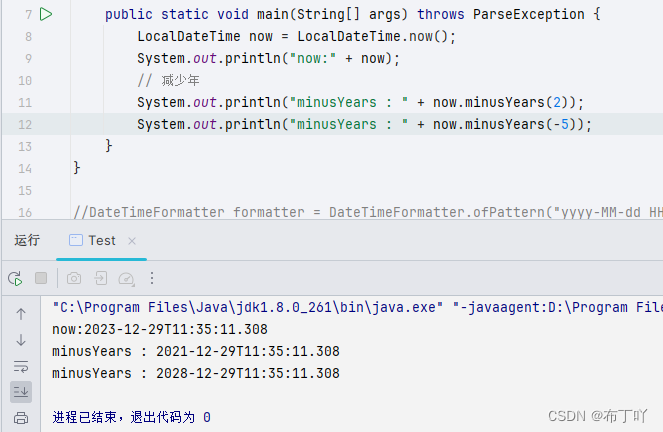
替换时间
| 函数声明 | 描述 |
|---|---|
| LocalDateTime withYear(int year) | 替换年(-999999999-999999999) |
| LocalDateTime withMonth(int month) | 替换月份(1-12) |
| LocalDateTime withDayOfMonth(int dayOfMonth) | 替换为本月中的第几天(1-31) |
| LocalDateTime withDayOfYear(int dayOfYear) | 替换为本年中的第几天(1-366) |
| LocalDateTime withHour(int hour) | 替换小时(0-23) |
| LocalDateTime withMinute(int minute) | 替换分钟(0-59) |
| LocalDateTime withSecond(int second) | 替换秒(0-59) |
| LocalDateTime withNano(int nanoOfSecond) | 替换纳秒(0-999999999) |
LocalDateTime now = LocalDateTime.now();
System.out.println("now:" + now);
// 替换年
System.out.println("withYear : " + now.withYear(1996));
// 替换月
System.out.println("withMonth : " + now.withMonth(5));
// 替换日
System.out.println("withDayOfMonth : " + now.withDayOfMonth(5));
System.out.println("withDayOfYear : " + now.withDayOfYear(5));
// 替换时
System.out.println("withHour : " + now.withHour(5));
// 替换分
System.out.println("withMinute : " + now.withMinute(5));
// 替换秒
System.out.println("withSecond : " + now.withSecond(5));
// 替换纳秒
System.out.println("withNano : " + now.withNano(5));

日期比较
| 函数声明 | 描述 |
|---|---|
| boolean isEqual(ChronoLocalDateTime<?> other) | 判断日期时间是否相等 |
| boolean isAfter(ChronoLocalDateTime<?> other) | 检查是否在指定日期时间之前 |
| boolean isBefore(ChronoLocalDateTime<?> other) | 检查是否在指定日期时间之后 |
DateTimeFormatter formatter = DateTimeFormatter.ofPattern("yyyy-MM-dd HH:mm:ss");
LocalDateTime time1 = LocalDateTime.of(1999, 12, 5, 10, 12, 12);
LocalDateTime time2 = LocalDateTime.of(1999, 12, 6, 10, 12, 12);
String timeStr1 = time1.format(formatter);
String timeStr2 = time2.format(formatter);
System.out.println("time1 : " + timeStr1);
System.out.println("time2 : " + timeStr2);
System.out.println(timeStr1 + " = " + timeStr2 + " : " + time1.isEqual(time2));
System.out.println(timeStr1 + " > " + timeStr2 + " : " + time1.isAfter(time2));
System.out.println(timeStr1 + " < " + timeStr2 + " : " + time1.isBefore(time2));
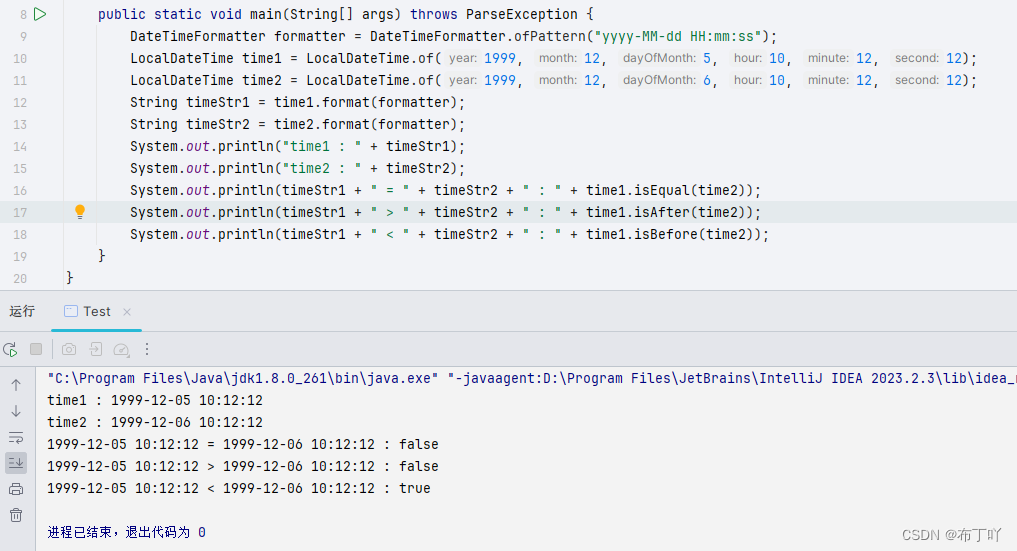
Java8新特性日期工具类的梳理到此结束,欢迎大家补充说明😉。
文章来源:https://blog.csdn.net/engerla/article/details/135292631
本文来自互联网用户投稿,该文观点仅代表作者本人,不代表本站立场。本站仅提供信息存储空间服务,不拥有所有权,不承担相关法律责任。 如若内容造成侵权/违法违规/事实不符,请联系我的编程经验分享网邮箱:chenni525@qq.com进行投诉反馈,一经查实,立即删除!
本文来自互联网用户投稿,该文观点仅代表作者本人,不代表本站立场。本站仅提供信息存储空间服务,不拥有所有权,不承担相关法律责任。 如若内容造成侵权/违法违规/事实不符,请联系我的编程经验分享网邮箱:chenni525@qq.com进行投诉反馈,一经查实,立即删除!
最新文章
- Python教程
- 深入理解 MySQL 中的 HAVING 关键字和聚合函数
- Qt之QChar编码(1)
- MyBatis入门基础篇
- 用Python脚本实现FFmpeg批量转换
- Oracle 游标混合使用
- 交换机详细指南
- 【评测脚本】agent资源监控
- VirtualBox安装openSUSE-Leap-15.5虚拟机并配置网络
- 数据科学与大数据技术就业方向
- k8s部署elastic+kibana
- AI芯片、GPU、算力、大模型
- anaconda镜像源,查看镜像,删除镜像,添加镜像
- 一文读懂算法中的时间复杂度和空间复杂度,O(1)、O(logn)、O(n)、O(n^2)、O(2^n) 附举例说明,常见的时间复杂度,空间复杂度
- 博客摘录「 PostgreSQL学习总结(1)—— PostgreSQL 入门简介与安装」2024年1月10日